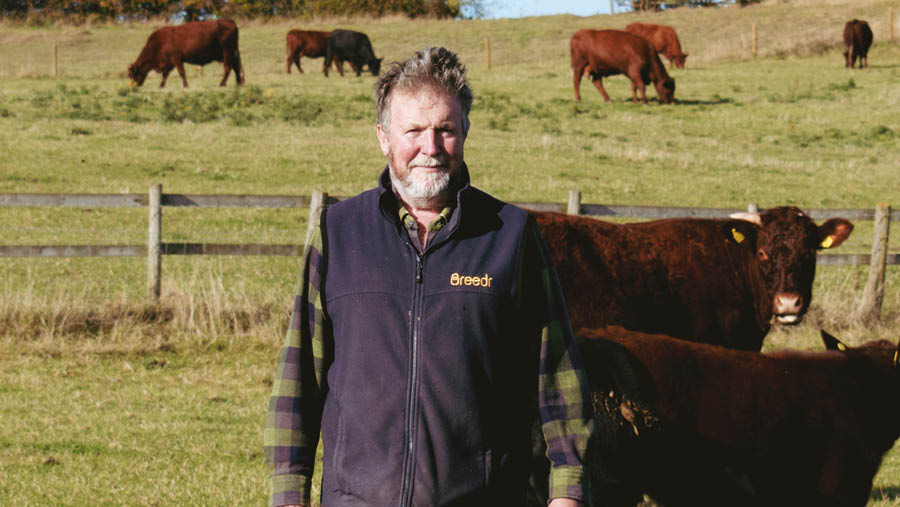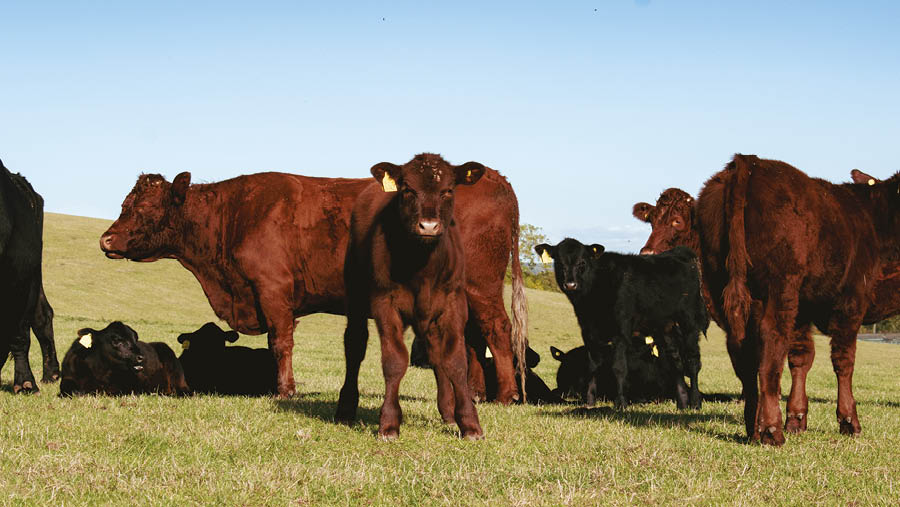How a beef farmer simplified herd management using genetics
 © MAG/Charlotte Cunningham
© MAG/Charlotte Cunningham With a job off-farm and a small pool of available labour, breeding “hands-free” cattle is a key priority for third-generation farmer Adam Quinney.
Reins Farm, near Stratford-upon-Avon, Warwickshire, comprises 150ha (370 acres) made up of multiple tenancies.
It is home to a 100-head suckler herd and a flock of 120 Easycare sheep, all managed by Mr Quinney and his wife, Sarah.
See also: 9 ways a farm is lifting beef cow efficiency
Farm facts
Reins Farm, Sambourne, Warwickshire
- 150ha (370 acres) of grassland made up of multiple tenancies
- 100 Salers cross Aberdeen Angus suckler cows, plus 120 Easycare sheep
- Breeding own replacements
- Young bulls bought from the same source for the past 10 years
- Cattle finished 22-24 months, averaging 350kg deadweight, processed by ABP
The goal of the business is to make herd management as simple and efficient as possible, while maintaining healthy margins.
To reach this, 10 years ago Mr Quinney introduced Aberdeen Angus genetics to his then predominantly Salers herd.
“While our Salers were extremely good mothers and very milky, there’s nothing like putting a bit of hybrid vigour into your herd.
“The idea of having Angus in the cows was to give them a little bit more cover than the Salers have and to make them polled because that was just another job to do,” explains Mr Quinney.
Alongside this, it was hoped the introduction of these genetics would improve mothering and calving ability to achieve that “hands-free” status he is aiming for.
Herd objectives
With more than half of his total costs attributed to overheads, having an animal that requires little labour input or costly management is crucial for maintaining margins.
“We are trying to make sure when we are spending anything that there is a good rate of return. It’s all about farming the margin for us – rather than total output of the animal.”
Mr Quinney says including Angus genetics within the herd is helping him meet three key objectives:
- Minimal/no assistance during calving
- Breeding cows that rear their youngstock well
- Progeny that grows and finishes well on grass-based diets to reduce reliance on inputs.
Breeding strategy
Achieving these objectives starts with breeding. The target of the breeding strategy is to end up with a cow that is three-quarters Salers and one-quarter Angus.
The cow is then put back to the Angus as a terminal sire, with the Angus genetics bringing good fertility and growth.
Estimated breeding values (EBVs) are a core part of the selection strategy. Bulls are selected at 15 months old from a single source – which has remained the only source over the past 10 years, explains Mr Quinney.
“With all EBVs, it’s about looking at the animal and then looking at the EBVs in conjunction with this. But primarily, we’re selecting for calving ease, fertility, robustness of the animal – good feet and so on – as well as performance throughout its lifetime.
“Maternal traits such as good teat placement are also important. On the terminal side, it is again about calving ease and lifetime performance, as well as achieving a sensible size of carcass.
“We’re not going for an extreme shape, just a good R4L animal.”

© MAG/Charlotte Cunningham
Fertility and calving
The benefits of the genetics and the close attention paid to the breeding strategy mean the herd is achieving more than 100 calves born to every 100 cows.
Over the past five years, Mr Quinney has only had to assist during calving twice – once at a complex twin birth and a second time due to a cow with a dead calf. “We consider it a failure if we have to calve a cow.”
He has also made changes to calving times. Over the past 10 years, the herd has moved from traditional spring calving in February/March to calving in June and July.
“I work off farm quite a bit, so I wanted to have the nice early mornings so that I could walk around and check the cows and then go off farm.
“It makes management easier, but also means that when we turn cows out in the spring, they all go out on the same day as one block.”
Feeding and rearing
The diet is grass-based. Traditional rotational grazing is a challenge because the grassland is made up of multiple parcels of land. To get round this, cattle are set stocked but rotated in paddocks within these areas.
The Angus’s ability to grow well on this grass is hugely advantageous as it reduces reliance on concentrates. This protects the business against rising, volatile input costs, says Mr Quinney.
Over the summer when cows are outside, they are achieving 1kg/day daily liveweight gain (DLWG). During the winter, cattle are housed and fed on largely home-grown, high-quality forage.
This is sometimes mixed with co-products such as brewers’ grain, but the ability of the genetics to do well on this forage means he is achieving DLWG of about 2kg/day during the winter months.
Mr Quinney says red clover in silage leys also has helped reduce reliance on fertilisers. And lucerne, now being grown as part of the rotation, is proving to be a more resilient species in times of drought – meaning cows are more likely to have something to graze year-round. This was proven this year when grass died off and lucerne kept growing – despite the drought.
“While it doesn’t yield as much [for silage], we can take more cuts. So, while our cutting costs are more, the dry matter [DM] yield gets up to about 10-11t/ha of good-quality feed.”
The result of this is growth from home-grown feedstuffs and less reliance on, and need for, bought-in feed. This means the business is less exposed to volatility of input prices, he adds.
But even with the best genetics, good management is fundamental to performance, says Mr Quinney.
“There’s an old saying that half the genetics are in a bucket of feed. Genetics are a long-term gain, so to get them to express that, the management has to be right.”
Finishing
All cattle are finished by 24 months. “We start to kill at 21 months, with the majority going by 22 months,” he says.
Cattle are sold deadweight to ABP with steer carcass weights averaging 350-360kg, and the heifers about 320kg.
While pushing the finishing age closer to 18 months might be possible if cows calved closer to March, and would reduce costs and management input further, Mr Quinney says this is a system that works well for them now.
“As we tweak the rations, and I’m at home more now, I think that age will start to drop. The genetics are there. But we’ve got a way to go yet.”
Data analysis
Record-keeping and “number-crunching” are key to ensuring genetic progression and form the basis of the replacement policy, says Adam Quinney.
“In essence, we want to make sure we’re not breeding from our worst cows.”
He looks at several performance indicators, including 200-day weight, which is crucial, he says. But this is not looked at in isolation, and performance within peer groups is also considered.
“We look at the best within first-time calvers and the best within our cows. This is because some of those first-time calvers will not perform as well in their first year as a cow in its fourth lactation, for example.
“But, they could be outperforming all of their peers – and [they are] the ones you may want to keep.”
Historic performance data is also important, with a focus on keeping and selecting heifers from the top quartile of consistently high-performing cows.
“The more data we’ve got, the stronger that evidence is.”
With footpaths running through about 70% of the farm, docility is very important to Mr Quinney. “If you walk into a field and she lifts her head, we don’t want her.”
He adds that he has also seen anecdotal evidence within his herd to show that docile cows have a better daily liveweight gain, strengthening the argument for the importance of this trait.
